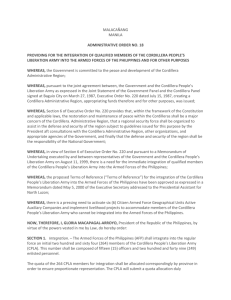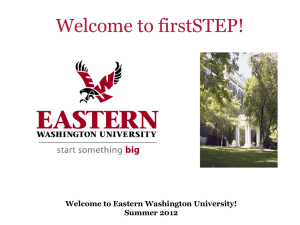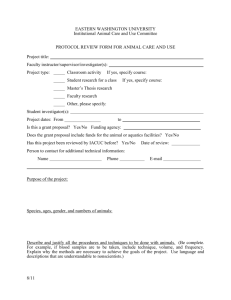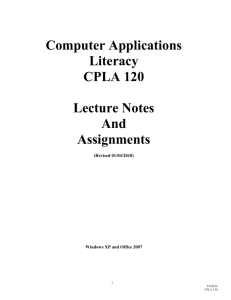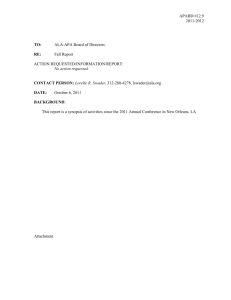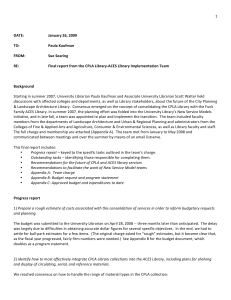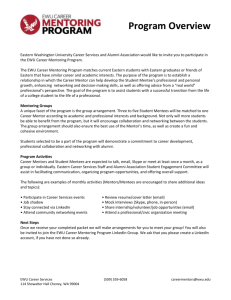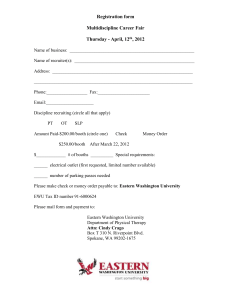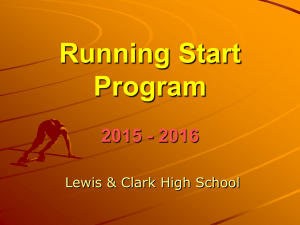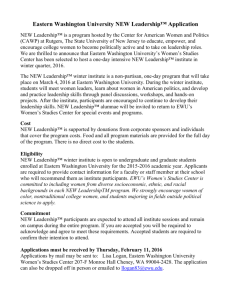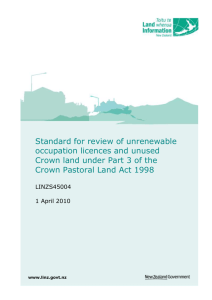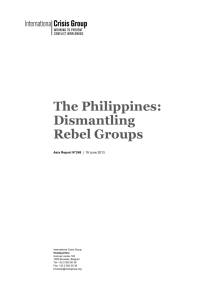Assessment Summary (Academic Year) 2010-2011
advertisement
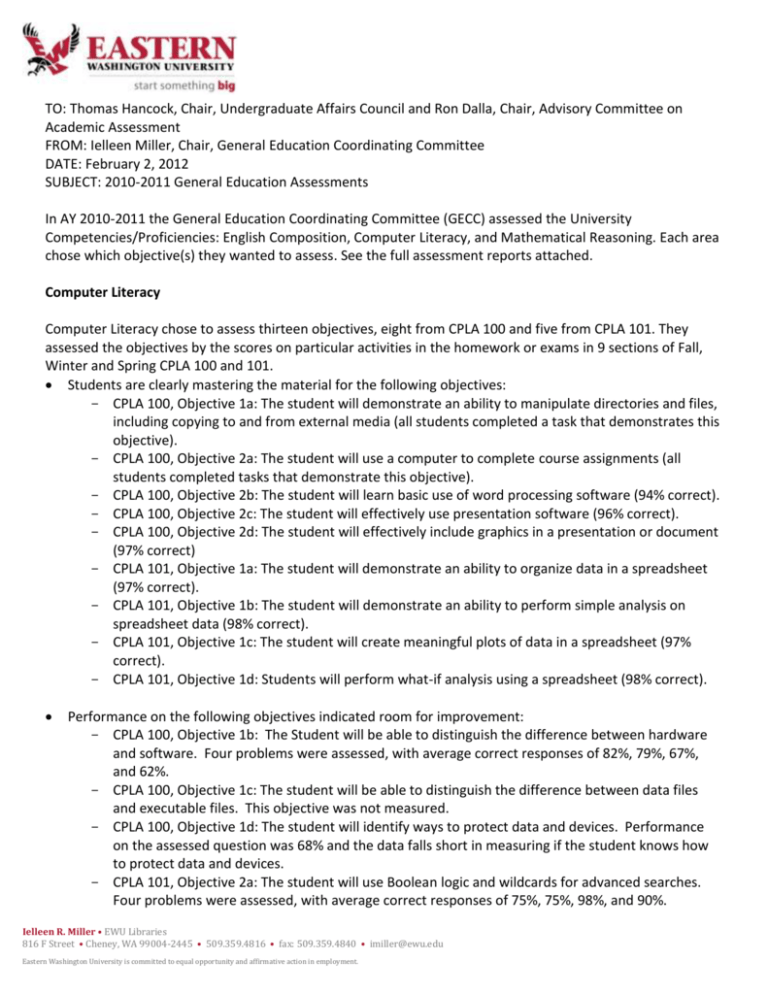
TO: Thomas Hancock, Chair, Undergraduate Affairs Council and Ron Dalla, Chair, Advisory Committee on Academic Assessment FROM: Ielleen Miller, Chair, General Education Coordinating Committee DATE: February 2, 2012 SUBJECT: 2010-2011 General Education Assessments In AY 2010-2011 the General Education Coordinating Committee (GECC) assessed the University Competencies/Proficiencies: English Composition, Computer Literacy, and Mathematical Reasoning. Each area chose which objective(s) they wanted to assess. See the full assessment reports attached. Computer Literacy Computer Literacy chose to assess thirteen objectives, eight from CPLA 100 and five from CPLA 101. They assessed the objectives by the scores on particular activities in the homework or exams in 9 sections of Fall, Winter and Spring CPLA 100 and 101. Students are clearly mastering the material for the following objectives: - CPLA 100, Objective 1a: The student will demonstrate an ability to manipulate directories and files, including copying to and from external media (all students completed a task that demonstrates this objective). - CPLA 100, Objective 2a: The student will use a computer to complete course assignments (all students completed tasks that demonstrate this objective). - CPLA 100, Objective 2b: The student will learn basic use of word processing software (94% correct). - CPLA 100, Objective 2c: The student will effectively use presentation software (96% correct). - CPLA 100, Objective 2d: The student will effectively include graphics in a presentation or document (97% correct) - CPLA 101, Objective 1a: The student will demonstrate an ability to organize data in a spreadsheet (97% correct). - CPLA 101, Objective 1b: The student will demonstrate an ability to perform simple analysis on spreadsheet data (98% correct). - CPLA 101, Objective 1c: The student will create meaningful plots of data in a spreadsheet (97% correct). - CPLA 101, Objective 1d: Students will perform what-if analysis using a spreadsheet (98% correct). Performance on the following objectives indicated room for improvement: - CPLA 100, Objective 1b: The Student will be able to distinguish the difference between hardware and software. Four problems were assessed, with average correct responses of 82%, 79%, 67%, and 62%. - CPLA 100, Objective 1c: The student will be able to distinguish the difference between data files and executable files. This objective was not measured. - CPLA 100, Objective 1d: The student will identify ways to protect data and devices. Performance on the assessed question was 68% and the data falls short in measuring if the student knows how to protect data and devices. - CPLA 101, Objective 2a: The student will use Boolean logic and wildcards for advanced searches. Four problems were assessed, with average correct responses of 75%, 75%, 98%, and 90%. Ielleen R. Miller • EWU Libraries [Type text] [Type 816 F[Type Street • text] Cheney, WA 99004-2445 • 509.359.4816 • fax: 509.359.4840 • imiller@ewu.edu Eastern Washington University is committed to equal opportunity and affirmative action in employment. text][Type text] [Type text] English Composition English Composition chose to assess Goal 3, Objective 2: Students will be able to form lists of sources representing diverse perspectives on a given issue and will be able to synthesize such sources objectively so that readers can understand the issue. They assessed the annotated bibliographies from 10 sections of English 201 in Spring 2011. Four criteria were evaluated on a scale of 1 to 5, 5 being best. Research Question: The Research Question is academic in nature, appropriately focused for the stage in the research process, and reflects the complexity of ongoing discussion on the issue. Average score = 4.07 Sources: The sources listed include necessary background information and reflect a range of scholarly/professional perspectives on the issue. Average score = 4.38 Format: Citations are properly formatted. They are arranged in alphabetical order using hanging indent and double spaced. All necessary information is included. Average score = 4.19 Annotations: Annotations reflect opportunities for co-inquiry and knowledge building by demonstrating the ability to synthesize. Thus, the annotations include the authority of the source, the relevant content of the source, the relevance to the student’s research question, and the connection to other sources. Average score = 3.96 The results demonstrated that English 201 is meeting the research goals. Students demonstrated an ability to develop effective research questions, find scholarly sources, and apply them to their own writing. English Composition felt that the objectives were met, but reflected that they could improve student learning by: Clarifying the assignment directions for and with students Focusing more class instruction on teaching students to contextualize their research, so that annotations are relevant to their own research process Completing at least one norming session of English 201 assignments each quarter to insure assignments and grading is consistent across all sections Mathematical Reasoning Mathematics chose to assess portions of Goal 1: Students will achieve mastery of specific mathematical tools applicable to problems encountered throughout the university curricula. Objective 9: Students will use descriptive techniques to analyze a set of observations of some variable, calculate and interpret measures of central tendency and variation, including mean, median and standard deviation. Objective 5: Students will identify the sample space and assign probabilities for the corresponding simple events for an experiment described verbally. Objective 7: Students will be able to calculate the probabilities of intersections and unions of events. Ielleen R. Miller • EWU Libraries [Type text] [Type 816 F[Type Street • text] Cheney, WA 99004-2445 • 509.359.4816 • fax: 509.359.4840 • imiller@ewu.edu Eastern Washington University is committed to equal opportunity and affirmative action in employment. text][Type text] [Type text] They used specific questions from 10 sections of MATH 115 (8 out of 9 sections from Winter 2011 and both sections from Spring 2011), and both sections of MATH 212 from Winter 2011. Results: Objective 9: Correct answers ranged from a low of 54% to a high of 85%, with an average of 72% Objective 5 & 7: Correct answers ranged from 3% correct in MATH 115, and in MATH 212 a low of 11% and a high of 88% correct answers, with an average of 62% correct. Mathematics felt that Objective 9 on the concept of mean was met. They thought that the lower scores may reflect students relying on their personal experience of the weather, rather than logic. But students in MATH 115 did poorly on the concept of probability, because they thought students were assuming all outcomes were equally likely, as well as the difficulty of the multi-step probabilistic situations. They will offer students plenty of opportunity to compare and contrast probabilistic situations, but not compare one-step with multi-step situations. By comparing MATH 115 to MATH 212 results, the faculty felt that the MATH 212 students did better because of the requirement to justify their work, and they want to emphasize this more in MATH 115. Ielleen R. Miller • EWU Libraries [Type text] [Type 816 F[Type Street • text] Cheney, WA 99004-2445 • 509.359.4816 • fax: 509.359.4840 • imiller@ewu.edu Eastern Washington University is committed to equal opportunity and affirmative action in employment. text][Type text] [Type text]
